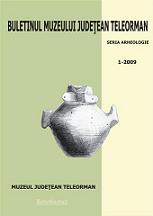O DEPUNERE RITUALĂ DE ANIMALE DESCOPERITĂ LA MĂGURA ‘BUDUIASCA’ (JUD. TELEORMAN)
A ritual animal deposition found at Măgura-Buduiasca (Teleorman county)
Author(s): Radian Andreescu, Bailey Douglass, Mills Steve, Katia Moldoveanu, Radu Valentin, Pavel Mirea, Adrian BălăşescuSubject(s): Archaeology
Published by: Editura Cetatea de Scaun
Keywords: Măgura ’Buduiasca’; 4th century AD; ritual deposition; taphonomy; biometry
Summary/Abstract: The Măgura ’Buduiasca’ site, discovered in 2001, is situated on the lower terrace of Teleorman River, in the South-East side of Măgura commune (Teleorman County). In 2004 campaign a pit (complex 36) was discovered in which were deposited as offerings three animals: two domestic cattle (an adult and a calf) and a bird (a goose). The complex is dated most probably to the 4th century AD. Considering the ’stratigraphical relations’ between the animals’ skeletons, the order of their deposition in the pit can be known: first, the adult cattle, then the calf, and finally the goose. Cattle parts were deposited in three groups: the legs and the pelvis and a part of the spine in the central-western side; the thorax in the northern side; and the head and neck in the eastern side. The cow was slaughtered in many parts; the calf was skinned and bent in two; and the goose was complete. As a whole, this ritual manifestation took part in at least two stages: one of sacrificing, slaughtering and taking of internal organs; and a second of deposition in the pit. Even though for the sacrificing, we cannot distinguish all of the activities performed on the animals, or the order of activity, or their significance, it is possible to notice (in the deposition stage) three moments in which humans gave special attention: 1) the deposition in the center of the pit of the three legs which had been detached from the adult cattle; 2) the deposition and arrangement of the calf over the neck of the adult cattle; and 3) the deposition and display of the goose on top of the adult cattle. The ritual depositions of these animals together (and in an almost complete condition) are unknown in the archaeo-zoological literature for this period.
Journal: Buletinul Muzeului Judeţean Teleorman
- Issue Year: 2009
- Issue No: 1
- Page Range: 131-148
- Page Count: 18
- Language: Romanian

